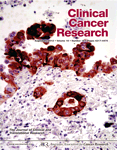Nanoparticle drug delivery helps reduce tumour metastasis
Nanotechnology is a topic that fascinates me, ever since hearing some interesting data in pancreatic cancer at the American Association of Cancer Research (AACR) meeting last November on Molecular Targets in Boston.
Someone kindly sent me a paper from PNAS recently (link below), from 2008, which got my attention essentially because:
"Integrin aBv3 is found on a subset of tumor blood vessels where it is associated with angiogenesis and malignant tumor growth. We designed a targeted aBv3 nanoparticle (NP) encapsulating the cytotoxic drug doxorubicin (Dox) for targeted drug delivery to the expressing tumor vasculature."
Now, giving doxorubicin by the normal route of administration results in noticeable weight loss and other side effects when given systemically. Using nanotechnology, a 15-fold increase in anti-metastatic activity without concomitant weight loss, which is very interesting indeed.
The authors noted that integrin could represent an ideal vascular targeting receptor since it is highly expressed on the angiogenic endothelium and expression of this receptor on tumor vessels correlates with disease progression. This was first shown by Gasparini et al., in 1998 (see reference source below).
Meanwhile, in this 2008 study, the researchers used models from renal cell and pancreatic carcinoma to determine the effectiveness of the nanoparticle delivery system. Given that the results appear better with metastatic rather than primary tumour growth, I wondered if anyone was looking at this concept with currently approved drugs for metastatic disease?
A quick search for nanoparticle and cancer in the clinical trials database brought up mostly trials associated with nanoparticle paclitaxel (Abraxane) from Abraxis ($ABII). Of course, one of the challenges here is that in animal research, drugs and nanoparticles can be injected directly into the tumour thus avoiding systemic effects, whereas in human research, nanoparticle drugs are more typically combined with regular drugs and infused as normal.
It was, hover, no surprise to learn earlier this year that Abraxane is looking promising in 2nd line advanced pancreatic cancer as a single agent after failure of gemcitabine-based chemotherapy. At AACR last year, researchers from Mass General showed that Abraxane targets the tumour stroma, depleting it, thereby reducing the impediment to chemotherapy. The Nab-paclitaxel utilises endogenous albumin pathways via binding of the albumin to secreted proetin acid rich in cysteine or SPARC. Interestingly, pancreatic cancer is known to overexpress SPARC and therefore offers a logical target for the drug. Abraxis reported in May that the median overall survival was 7.3 months, which is impressive in a very hard to treat refractory population.
I wonder what the Nab paclitaxel data would look like in front-line treatment in combination with gemcitabine? Or what about using it in advanced renal cancer with any of the half dozen drugs already approved but with limited effectiveness? Would adding a nanoparticle delivery system such as Abraxane to the mix reduce metastasis, deplete the stroma and improve access to the tumour for the anti-angiogenic agents?
Overall, it's an interesting technology concept for improving drug delivery and we're still at relatively early stages of research. Hopefully, we'll hear more about nanotechnology and the broader application of new combination nanoparticles to cancer treatment in the near future. It takes significant investment, creativity in trial design and an intensive yet broad research program to drive results though. Celgene ($CELG) have since bought Abraxis and may be more willing to aggressively invest in the growth of this interesting drug.
I must say that the AACR Molecular Targets and Cancer Therapeutics meeting every November is one of my all time favourites, but it alternates with Europe every other year and will be in Berlin this November, so depending upon my schedule I may not be able to make it this time 🙁
![]() Murphy, E., Majeti, B., Barnes, L., Makale, M., Weis, S., Lutu-Fuga, K., Wrasidlo, W., & Cheresh, D. (2008). From the Cover: Nanoparticle-mediated drug delivery to tumor vasculature suppresses metastasis Proceedings of the National Academy of Sciences, 105 (27), 9343-9348 DOI: 10.1073/pnas.0803728105
Murphy, E., Majeti, B., Barnes, L., Makale, M., Weis, S., Lutu-Fuga, K., Wrasidlo, W., & Cheresh, D. (2008). From the Cover: Nanoparticle-mediated drug delivery to tumor vasculature suppresses metastasis Proceedings of the National Academy of Sciences, 105 (27), 9343-9348 DOI: 10.1073/pnas.0803728105
Gasparini G, Brooks PC, Biganzoli E, Vermeulen PB, Bonoldi E, Dirix LY, Ranieri G, Miceli R, & Cheresh DA (1998). Vascular integrin alpha(v)beta3: a new prognostic indicator in breast cancer. Clinical cancer research : an official journal of the American Association for Cancer Research, 4 (11), 2625-34 PMID: 9829725

![Reblog this post [with Zemanta]](http://img.zemanta.com/reblog_e.png?x-id=c489c468-e881-43be-9599-dff5df222421)
![Reblog this post [with Zemanta]](http://img.zemanta.com/reblog_e.png?x-id=aa1142f5-66f9-41f7-9b59-7d8ded2c5a2d)